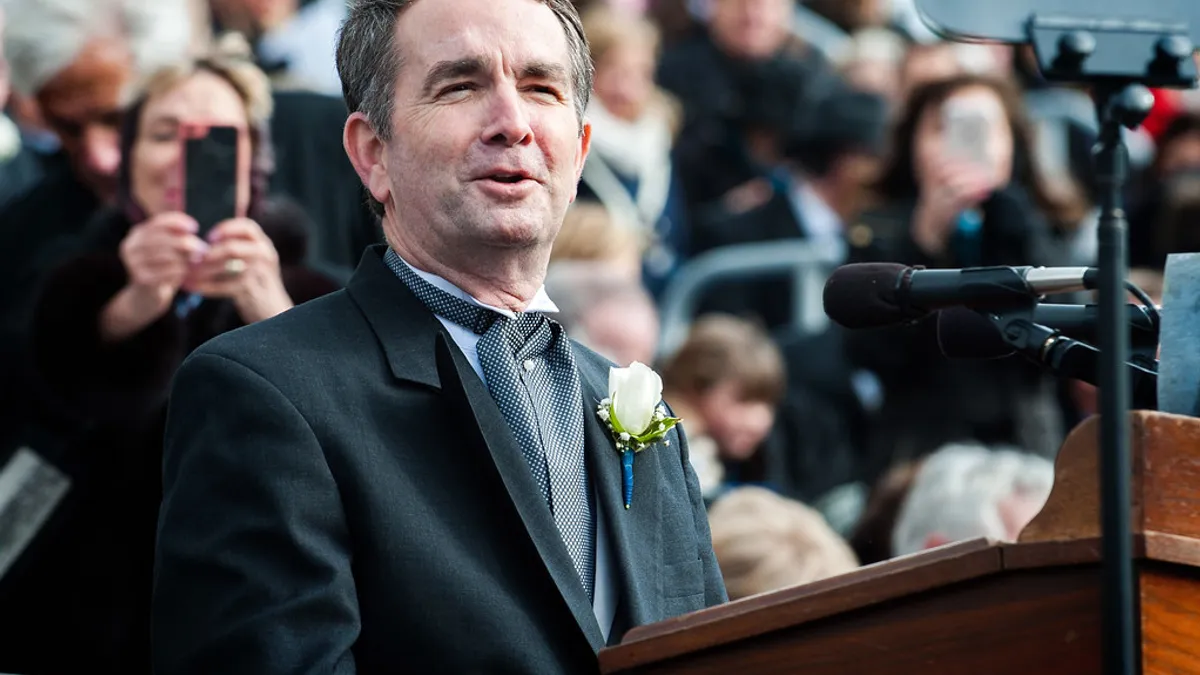Dive Brief:
-
Virginia Gov. Ralph Northam, D, on Tuesday signed an executive order calling for the state to reach 100% carbon-free power by 2050 and 30% renewables by 2030.
-
The order directs regulators to establish a path to a carbon-free electric sector through solar, wind, energy efficiency and energy storage supplied by Dominion, the state's monopoly utility. It also directs regulators to reduce Virginia's electricity consumption 10% below 2006 levels, and for state agencies to get 30% of their electricity from Dominion-powered renewables by 2022.
- The state currently generates 6.8% of its electricity from renewables, which includes burning biomass under Virginia law, and the majority of its carbon-free power comes from nuclear, according to the U.S. Energy Information Administration.
Dive Insight:
As states move toward more ambitious clean energy goals, some renewables advocates say broader reform is needed to change the way utilities are incentivized. Virginia has faced particular scrutiny in recent years for its mostly vertically integrated market, which advocates say limits customer ability to choose clean energy options.
In order to accomplish the shorter term 30% goal, the governor's order directs the Secretary of Commerce and Trade, the Department of Mines, Minerals and Energy, and the Department of General Services to "negotiate amendments to the statewide Dominion energy contract to include the additional purchase of energy from utility-scale onshore wind and solar facilities."
Virginia has a statewide goal of procuring 5.5 GW of onshore wind and solar by 2028, and the governor's order now mandates at least 3 GW of that generation to be under development by 2022.
The order also addresses offshore wind, which Dominion has expressed interest in, but has not fully fleshed out. Now, 2.5 GW of offshore wind power must be operational by 2026 under the order.
"Challenge accepted," Dominion spokesperson Samantha Moore told Utility Dive in an email. "The Grid Transformation and Security Act allows us to accomplish many of the clean energy goals laid out today," she said, referring to the 2018 law that focuses on grid modernization and renewable energy investments. "We look forward to working with the Governor and stakeholders on next steps needed to accomplish all of them," she added
But many stakeholders in the state have been frustrated with Dominion in recent years, including clean energy groups, customer advocacy groups and residential and large customers for its high costs and lack of renewable energy and efficiency investments.
Earlier this month, state regulators found the utility collected $277.3 million more than it was authorized in 2018, but Dominion cited the Grid Transformation and Security Act, which expanded the utility's authority to invest surplus revenue to get it to invest in more clean energy technologies.
Tech giants in May called on the utility to include more storage and renewables options and other large business customers, such as Walmart and Costco, have attempted to leave the utility's service, complaining its cost structure is "excessive."
In response, stakeholders have been calling on the state to eliminate the monopoly structure entirely and move toward a more competitive retail market, allowing third party providers to offer renewable energy options.
Increased competition is the best way to reach the state's ambitious goal, Cassady Craighill, communications director at Clean Virginia, a member of the Virginia Energy Reform Coalition, told Utility Dive.
A more open market will create incentives for power providers to be more efficient and meet customer demand for cheaper, cleaner power, she said. "I wish more people would talk about utility reform when they talk about climate change."















